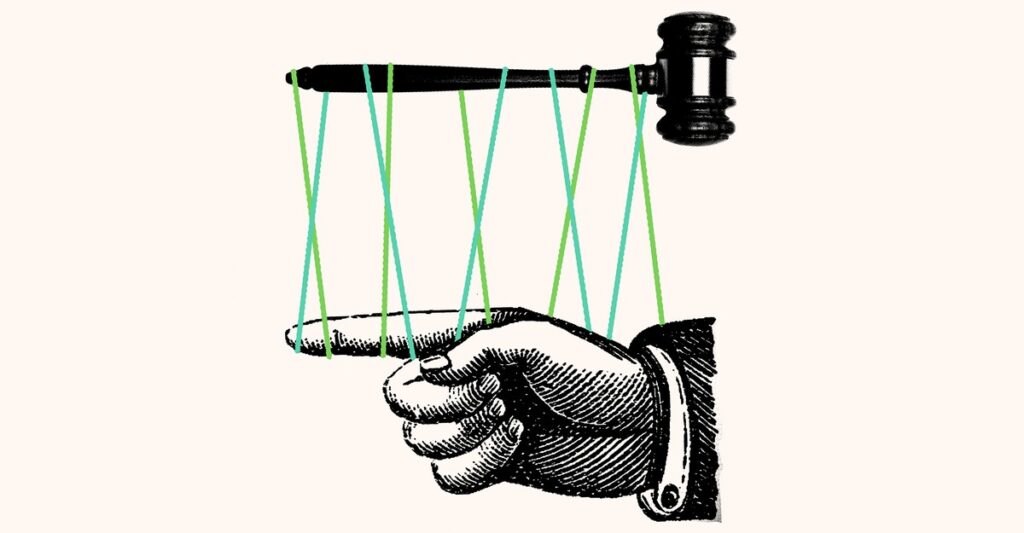In President Donald Trump’s second administration, the key political battles so far have turned on the question of who should decide big, important things: which immigrants are deported, which funds are distributed, which bureaucrats are fired, which vaccines are approved. The new administration’s answer to nearly all of these questions is that Trump should decide. This has left many Democrats incensed. Trump is not a monarch, they charge. Our constitutional system precludes him from making these changes unilaterally. Executive authority needs to be curtailed.
But just last year, when the Supreme Court overturned a Reagan-era decision requiring federal judges to defer to bureaucratic expertise, progressives were singing a different tune. They were aghast at the prospect of legislators and judges impinging on executive-branch decisions. They wanted to protect Biden-administration prerogatives. Democrats may not want Trump’s lackeys wielding authority, but set the personnel aside and they’re still fundamentally at odds with themselves about which institutions should make important calls.
For Trump’s detractors, this is an enormous, if underappreciated, problem. Democrats are, at root, the party of government—they believe that public authority is key to improving people’s lives. Yet government, according to most Americans, simply doesn’t work today. Every big public decision seems to get mired in endless wrangling and legal complications. We’re not building infrastructure, or harnessing clean energy, or keeping up with housing demand. Given that reality, Trump’s reelection is not hard to understand. In the face of a failing system, voters were eager to empower someone to shake things up—and that’s exactly what Trump promised to do.
To beat the Trumpian zeitgeist, Democrats will need a plan for making government work. But to make that notion plausible, they will need to wrestle with the core contradiction that bedevils their governing ideology. Progressivism today wants at once to allow government to make big decisions efficiently and to ensure that no one gets snowed in the process. To that end, they decided decades ago to throw their lot in with a notion that procedure can replace discretion. Today, we are all living with the consequences of that mistake.
From progressivism’s founding in the late 19th century into the 1960s, the movement offered a simple answer to the question of who should decide. Scientifically driven expertise was, to the progressive mind, the key to good public policy. That meant authorizing expert public officials—the establishment—to stand up holistic solutions to big challenges. Let the engineers design good sewer systems. Let the social workers design proper social-safety nets. Let the medical professionals design the health-care system.
New Deal Democrats extolled the “wise men” and “city fathers” wielding broad tranches of public authority. The establishment produced New York’s Port Authority, the Tennessee Valley Authority, the Social Security Administration, the Marshall Plan, and the Federal Highway Administration. On issues of great public import, progressives agreed that big bureaucracy might not be beautiful, but it got the job done.
By Jimmy Carter’s presidency, however, progressives had lost that faith. Urban renewal robbed Americans of their confidence in municipal government. Vietnam had taken away the progressive reverence for the military. The civil-rights movement had exposed the bigotry within the governing class. And Watergate had revealed just how sick and self-serving the power elite really were.
But progressivism’s sudden turn against the establishment left reformers in a quandary. If they couldn’t trust the experts to exercise authority, who would make important decisions in their stead? Who would decide where to build the new bridge crossing the river, or which neighborhoods were going to be compelled to accommodate new housing projects? The answer seemed obvious—the people would decide.
But amid the rush to decapitate the establishment—to end the war, to snuff out racial discrimination, to speak truth to power, to “put your bodies upon the gears and upon the wheels”—the question of just how the people would decide was left hanging. The problem, to the progressive mind, was that fallible bureaucrats and elected officials had been imbued with too much discretion. To counter unconstrained discretion, progressives would seek to impose process.
Having witnessed the abuse of authority, reformers resolved to provide the victims of the system with the means of protecting themselves. The people would be given seats at the table, voices in the deliberation, and opportunities to appeal when bureaucrats tried to bowl them over. They would lean on the courts’ authority to stop the executive branch in its tracks. Discretion, after all, was primarily the province of the executive and legislative branches. Progressivism’s new project was to move power from those two branches and into the third—which, if nothing else, had the power to say no.
If progressives a generation earlier would have been shocked to witness the movement’s turn against the establishment, they would have been gobsmacked to see reformers lionize the courts. For most of the movement’s early history, judges had been cast as the villains. They’d shielded trusts and monopolists from prosecution. They’d eviscerated minimum wage and maximum-hour statutes. They’d upended various elements of the early New Deal. Franklin Roosevelt had complained that judges wanted to take the country back to the “horse and buggy days.” Now progressives changed their tune: It was the executive and legislative branches that were suspect and veto-wielding judges who were knights in shining armor.
Drastic as this turn may have been, it was catalyzed by a novel political reality. The judiciary, which had so frustrated Roosevelt, had taken on a very different character by the time Richard Nixon haunted the West Wing. The conservative justices who had upended elements of the New Deal had been replaced by the likes of Thurgood Marshall and William Brennan. The progressive Judges Skelly Wright and David Bazelon, meanwhile, served on the D.C. Circuit Court of Appeals. But if the old conservatives had championed laissez-faire, and the new crowd embraced what critics would call “judicial activism,” the two sets shared something profound: a deep skepticism of the elected branches. And by the late 1960s, progressives everywhere shared that same mindset.
During the three decades when first Earl Warren and then Warren Burger served as chief justice, the Supreme Court operated as a bulwark against the abuses of elected officials and bureaucrats alike. The Court told local governments that they had to desegregate their schools, that police officers could no longer coerce unsuspecting citizens into self-incrimination, that politicians could no longer prevent journalists from publishing unflattering articles, and that policy makers could no longer prevent women from making their own health-care decisions.
But the impulse to curb the establishment’s power also extended into other realms. By the 1970s, ordinary people were tired of highway engineers imperiously disrupting neighborhoods in their zeal to construct expressways. They were tired of developers razing whole neighborhoods in the name of utopian schemes for glittering high-rises. They were tired of utility executives colluding with public officials to license smog-inducing power plants.
The great social triumphs of the Warren and Burger Courts are seldom considered in tandem with contemporaneous decisions issued to protect the environment, preserve historically significant buildings, and preclude a president from going to war without proper authorization. But they all were grounded in the same underlying effort. The centralized power brokers whose discretionary power emanated from the elected branches had turned bad; progressivism would return that authority to the people using processes governed by the courts.
If the courts grew more likely to veto the decisions taken by officials, though, they seldom stepped in to make the decisions themselves. That left progressives to answer a pressing question: If government officials couldn’t be trusted, then who should decide?
In some cases, the answers seemed simple to them. When it came to abortion, for example, the pregnant woman should make the call. When a Black family was looking for a place to spend the night, they themselves should be able to choose among all the various public accommodations. But what about when the highway department proposed an expressway for suburban commuters and those living along its route worried about noise and pollution? Who would decide when the people weren’t united against the powerful but instead were arguing among themselves—when the issue wasn’t a Manichean struggle between right and wrong but a messy question of trade-offs?
Progressives sidestepped this question by immersing themselves in proceduralism. Reformers imagined that if everyone was able to have their concerns taken seriously, some correct answer would eventually emerge. Each affected party needed to be able to exercise some real power, and to be able to appeal for the protection of the court. If a process came to the wrong conclusion, those poised to suffer could demand that a judge throw the emergency brake.
Those opposing a project no longer had to debate proposals on the merits; the question was no longer about the wisdom of any official’s exercise of discretion but about whether the process had been properly followed. Had the affected communities been consulted with enough notice? Had they been given sufficient time to respond? Had all the impacts—on wildlife, on noise, on sunlight, on historic buildings—been taken into account? Opponents no longer had to argue that their concerns substantively outweighed the merits of any proposed project. Procedure was now king. And on process-oriented questions, the judiciary veto reigned supreme.
But even the best process cannot obviate the need for trade-offs. Nobody wants a sewage-treatment plant sited near their neighborhood, but cities sometimes need to filter water. No community wants to be sliced by a new transmission line, but the nation’s electrical grid needs to be enhanced. Sometimes, inconveniences can be offset by new amenities—a neighborhood forced to host a new homeless shelter might be bequeathed a new recreation center. But no new ice rink is going to compensate for the disruption wrought by the construction of a new high-speed rail line. In many cases, there’s no way around a simple reality: Someone’s ox is going to be gored.
The old establishment power brokers have never been formally stripped of their discretion. Transportation officials are still in charge of where the next expressway will be constructed. Utility executives are still charged with deciding where the next transmission line will go. Mayors, governors, and development officials still get to make the call on various proposals to build more housing. But in reality, the processes created to regularize and democratize these decisions—the boards that need to weigh in, the considerations that need to be studied, the hurdles that need to be cleared—have effectively eviscerated their actual discretion. Failures to heed some element of the process invite lawsuits. And once any disagreement lands in litigation, the real decision-making power is vested in a judge.
That, of course, was precisely the reformers’ intention. For decades, progressives viewed the shift from discretion to procedure as a change that effectively took power out of Richard Nixon’s hands and placed it in Thurgood Marshall’s. But as the courts have turned more conservative—Samuel Alito is no Bill Brennan—that faith has wavered. More important, progressivism has begun to rethink the underlying wisdom of that shift.
At the dawn of the progressive movement, reformers had wanted government to do big things. Institutions were created on the express promise that the experts would run them. Only during the 1960s and ’70s, as abuses of power were exposed, did the movement begin to venerate the judiciary. That worked well enough so long as the communities the movement cared to serve were better off without big changes—housing starts, grid enhancements, public infrastructure. But decades on, amid housing shortages, dilapidated infrastructure, and the threat of climate change, many reformers have been forced to reconsider.
In the early 20th century, progressives were frustrated that a judicial approach born from conservatism—what W. E. B. Du Bois would label “the counter-revolution of property”—prevented government from pursuing policies to help the poor and working classes. Today, by contrast, progressives may be similarly enraged by a conservative Supreme Court—but their frustration is born from a jurisprudence of their own making. The shift toward proceduralism had been an explicitly progressive endeavor. Progressives wanted to throw sand into the gears of the machine. Now, as they dream of doing big things again, they are left to shake their fists at their own legacy.
Think of the young activist groups protesting against solar farms, or liberals bucking reform efforts to build multifamily housing in the suburbs. It was the left, too, that undermined a late-Biden-era effort to speed permitting for clean-energy projects for fear that some fossil-burning facilities might also get a boost.
To be fair, these examples reflect real conflicts. Some will be incensed that anyone would stand in the way of a wind or solar farm, others outraged at the way those farms may affect the existing wildlife. Some will be irritated that longtime residents might stand in the way of new housing construction, others indignant at the prospect of gentrification. The problem here isn’t that the movement isn’t of one mind on the merits of any given idea. Rather, it’s that reformers have no real concept of a process that would fairly arbitrate between trade-offs. Any adverse outcome—and when trade-offs are required, there is definitionally an adverse outcome for someone—is a signal that the underlying decision-making process is corrupt.
Who, then, speaks for the people? Congress might be the most obvious answer, legislators being directly tethered to the interests of their constituents. Ironically, however, progressives tend to find representatives and senators among the least appealing options. Members of Congress are prone to capture by powerful interests and deep-pocketed donors. Even if they resist those temptations, they tend to prioritize the concerns of their district or state to the detriment of society as a whole. If nothing else, earmarks short-circuit the deliberative process that might identify the best way forward. Decades after money was scandalously tucked away for Alaska’s “bridge to nowhere,” the project remains a cautionary tale about the abuse of legislative power.
But of course, progressives remain wary of executive authority as well. A 2008 episode of This American Life reported that Black communities across America still live under the specter of what’s known in conversation as “the Plan” to gentrify poorer neighborhoods, a folk belief born in the era of urban renewal that has proved remarkably persistent. A movement that continues to lionize speaking truth to power remains wary of bureaucracy, convinced that agencies, like legislators, are easily captured by private interests. To protect against that kind of abuse, it continues to rely on the courts.
But the courts, as arbiters of various rules, aren’t really equipped to push forward the kinds of progress that progressives mean to champion. They can certainly halt change, as progressives were so eager for them to do when the establishment was running amok. But even now, judges cannot make the discretionary calls about where the bridge should be built, or the sewage plant sited, or the transmission corridor erected.
Skeptical that anyone wielding power can be trusted to make a truly wise or disinterested decision, progressives end up judging every process by the outcome. And when the battle is less between right and wrong than between one set of trade-offs and another, cynicism quickly gives way to despondency. Rather than face the hard reality that housing projects, transportation networks, and clean-energy facilities are inevitably going to come with costs, reformers view the simple existence of those downsides as evidence that the public is getting a raw deal. Thus progressives almost inevitably make the case that government is fundamentally broken. And they’re right—government is broken, in large part because they broke it.
It’s not that Democrats are at a loss for ideas today. It’s not that they are unable to identify enemies—greedy bankers, polluting corporations, Elon Musk. Rather, the party has lost the will to govern. It cannot figure out how to set priorities, identify choices, ratify trade-offs, and then accept the costs of important decisions. For decades, progressivism has deluded itself into believing that process can obviate the need for discretion. Reformers became so obsessed with ensuring that government would not trample the powerless that they have prevented government from doing its job.
Few voters, of course, would have articulated their frustrations with progressivism that way while casting ballots for Donald Trump. But Democrats’ determination not to let government govern—the progressive movement’s cultural aversion to power—was baked into the campaign. The Biden administration invested billions in infrastructure, high-speed rail, and clean energy, but not in ways that voters could see, touch, or appreciate. Two years after the government appropriated $5 billion for EV chargers, only a few dozen had been built. The country is in a housing crisis, but the government didn’t clear the way for new home construction. Voters overwhelmingly reported that America was on the wrong track, and yet Democratic leaders weren’t righting the train.
A growing movement of so-called supply-side progressives is now trying to address this problem. Those joining in what the Atlantic’s Derek Thompson has framed as a quest for “abundance” are searching for ways to form what the New York Times columnist Ezra Klein has termed a “progressivism that builds.” But even within the growing community of scholars and activists convinced that government’s inability to drive progress is a substantive and political problem, answers to the core question of who should decide remain elusive. Everyone seems to want more stuff and less rigmarole. But in the same way that previous waves of reform focused on chopping away things proponents didn’t like, today’s reformers risk sidestepping the crucial question of who should ratify any given trade-off.
In the realm of housing, the abundance crowd has begun to sketch an appealing answer: Let the free market choose. The problem, they suggest, is fairly simple. People in the suburbs don’t want multifamily buildings constructed nearby, lest the riffraff move in next door. People in grittier neighborhoods fear that new construction will bring higher rents. On both ends, would-be neighbors conspire to preclude any influx of newcomers by constraining what property owners can do.
As The Atlantic’s Yoni Appelbaum argues in his new book, Stuck: How the Privileged and Propertied Broke the Engine of American Opportunity, we should lift those restrictions, letting the people who purchase land build what they want, whether it’s a duplex on a single-family plot, a granny flat above their garage, or a multifamily building near a bus stop. The tension between those who own a plot of land and those who live nearby should be resolved in favor of the figure who controls the property. The supply-side solution, in the realm of housing at least, is to push decision-making power down.
But there is, of course, another potential approach. Rather than limit the opportunities for neighbors to gum up the works, progressivism could reach back into its ideological roots and empower someone with the discretion to clear the way. Instead of deconstructing the barriers that preclude more housing, reformers could affirmatively assign someone to cut through the cacophony of objections and devise a solution that serves the public interest.
To address housing shortages, for example, an official could weigh the pros and cons of any given proposal—considering both the promise of the project and the objections of those nearby—and use their better judgment to decide whether the idea should move forward. The person who owned the plot would not have an absolute right to build, and those worried about neighborhood impacts would not have the power to thwart any change. Authority, in other words, could be pushed up.
Returning the exercise of discretion to public officials cuts against progressivism’s half-century-long campaign to curtail the establishment. Better, many will argue, to establish a process of some sort to regularize consideration. But even if we can make progress in addressing the housing shortage by pushing power down, that can’t be the way forward on transportation or clean energy, because the landowners themselves object to the needed developments. And that’s exactly the point. None of the hard decisions America faces—weighing preservation against new housing, or clean energy against environmental protection, or neighborhood stability against high-speed rail—can be resolved without significant trade-offs. The notion that nothing works can be cured only by a process that makes decisions expeditiously.
That’s not to suggest that all of the guardrails should be removed. Reformers can require decision makers to mitigate harm—to do the least possible damage to the forest, or preserve as many homes in the train’s right-of-way, or demand that the new multifamily buildings erected in a vibrant community hew to a familiar aesthetic. But, in the end, someone needs to be put in charge.
That will be a frightening prospect for many reformers. But if progressives mean to dull the sting of MAGAism—that is, if they intend to make progressivism popular again—there is no alternative. Trump’s return to power wasn’t inevitable—and it certainly wasn’t born of any single ideological failing on the left. But progressivism’s decades-long effort to replace discretion with process has proved a disaster.
The movement wasn’t wrong during the 1970s in wanting to correct for abuses wrought by the establishment, but the tonic has by now proved to be more toxic than the disease. For progressivism to reestablish itself, it will need to make government work. And for government to work—for people to believe that democracy really serves their interests—the individuals who nominally wield public authority need to be given the discretion, at long last, to use it for the greater good.
Premium IPTV Experience with line4k
Experience the ultimate entertainment with our premium IPTV service. Watch your favorite channels, movies, and sports events in stunning 4K quality. Enjoy seamless streaming with zero buffering and access to over 10,000+ channels worldwide.

















